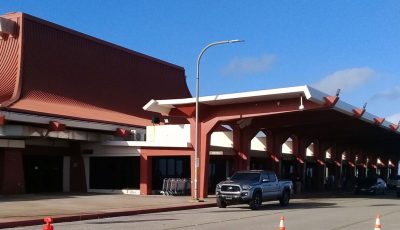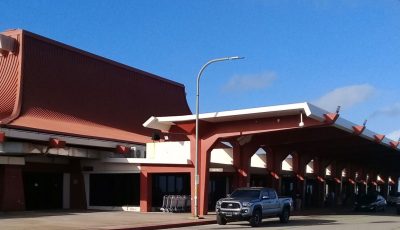1,600 passengers stranded—MVA
Downed vehicle forces CPA to reduce index of operations
The Francisco C. Ada/Saipan International Airport was forced to restrict the size of aircraft that can fly in with passengers, after a runway firefighting truck went down for maintenance last Friday. This stranded about 1,600 passengers over the weekend, local tourism and airport officials said yesterday.
The Commonwealth Ports Authority says they are urgently tracking and have expedited the arrival of equipment to repair the Airport Rescue and Firefighting “Crash 8” unit vehicle.
The ports authority expects the equipment—or a steering gear box—to arrive this morning from a manufacturer out of Oshkosh, Wisconsin. They expect a window of eight to 10 hours for their mechanics to complete repairs.
Dynamic Airways, Sichuan Airlines, and China Eastern flights were the “most affected,” according to CPA executive director Maryann Lizama.
Federal Aviation Administration regulations mandated CPA to reduce their index of operations.
“A lot of people are questioning the unpopular decision that I made, but we will always err on the side of caution, and we will never compromise safety,” Lizama told Saipan Tribune in an interview yesterday.
Dynamic’s local representative Dennis Tse said they flew rescue flights over the weekend. The last ones were scheduled to fly in yesterday, according to him.
Lizama said that with much consultation and guidance from the Federal Aviation Administration, they were given exemption to “ferry in and live-out” planes.
“…Which mean the regular aircraft comes in empty—just the pilot and crew—and they leave full,” she said.
“Right now all airlines can only [live-out and ferry-in] if their aircraft is bigger than restriction. And it is only for rescue flights,” Tse also said.
“As soon as CPA says that there’s no more restriction, we will resume our normal operation,” he added.
Meantime, the Marianas Visitors Authority confirmed over a thousand passengers stranded over the weekend.
“Yes, our estimate is about 1,600 pax stranded,” said MVA managing director Perry Tenorio in an email.
Smaller flights
The Saipan International Airport is an “Index D” operations per FAA guidelines. This index allows larger planes to like 747s, 777s, Airbus 380s, and Airbus 330s to come in.
Because CPA’s crash unit became inoperable, the ports authority had to reduce index to “Index C” because there was a reduction in their response capabilities.
“We have to match up the size of the aircraft that come in with our response capabilities,” Lizama explained.
Index C—per the FAA—indicates that aircraft between 129 feet and no more 159 feet in size are allowed to land.
Since the reduction in index, Asiana Airlines had to downgrade their aircraft to an Airbus 321.
According to the local Asiana office, they flew two Airbus 321s yesterday to accommodate the passengers that were set to fly in on one 747.
Asiana was scheduled to fly out at 8:20pm an Airbus from Korea, which was to arrive on Saipan at 1:50am today. It was set to leave at 3:20am.
Another Airbus was set to leave Korea at 8:40pm yesterday, arriving at 2:10am today and leaving at 3:40am.
Asiana staff said the same number of passengers is still coming in but on two planes.
The Crash 8 unit
In an interview, Lizama said they get audited by the FAA and get inspected on their ARFF trucks, so “there is no fooling around, when it comes to the service care and maintenance.”
“It plays a huge role in our response capabilities,” she said.
The Crash 8 unit has been around since 2003, according to her.
“We don’t plan break downs. Because of her age, it is wear and tear. We had a required number of hours to try and fix her up as much as possible—we were not able to do that, so on the 11th hour, on the required hour she was not able to get fixed, we had to issue [a notification based on the Federal Aviation regulation]” to shut her down. We didn’t sleep on these things. We did everything that we possibly could to find alternatives to try and fix her up, and when we couldn’t,” CPA ordered a steering column via DHL.
“We are hoping the parts come in, in the early morning flight, and we already have our mechanics and our boys on staff on standby to start working on the repairs. When the parts does get here, our mechanics are going to need eight to 10 hours, to put in the assembly as safely as possible.”
Alternatives, and new trucks
Lizama says they reached out to local fire stations, the Guam International Airport Authority, and Micronesia airport partners for “alternatives,” but in the end, they couldn’t use a local fire truck because the ARRF craft has specific fire retardants required to be in the compartment of a truck to be able to kill fire on a plane’s fuselage.
Lizama said because they didn’t have the parts, they reached out to regional airport partners, but they did not have the equipment in stock.
“We’ve reached out but what needed to be done was to order the entire assembly.”
When asked, Lizama said the islands of Rota, Tinian, and Saipan were ordered new trucks way before the recent situation.
The trucks are 1,500-gallon trucks, she said. Saipan would get two, she said.
“Right now they are on the manufacturing stage. They are being built.”



























